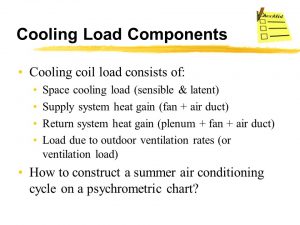Air conditioning load is the rate where sensible heat must be removed form the indoor environment to maintain a continuous indoor humidity and temperature. Sensible heat to the indoor environment triggers the indoor air temperature to increase while latent heat is connected with the increase of the water content in the indoor atmosphere. A fantastic way to measure the ac load on an area is to add up all the warm-up bicycles and cool-down cycles to acquire a total heat consumption of the entire room. This system is also helpful to know more about the ac load in a area and to have an overall idea about the quality of atmosphere in this room.
Air Conditioning Load
To measure the air conditioning load on an area, you have to consider two things; exterior temperature and outdoor humidity. If the outside temperature stays constant, there’s almost no load on the area as the heat does not radiate out. Thus we can say that the outdoor temperature does not have any bearing on the measurement of air load load. However, if the outdoor temperature increases, then there is definitely a dew point in that room and it’ll increase the load on the ac system to a certain level.
Air Conditioning Load
- When it comes to outdoor temperatures and humidity, the dew point doesn’t have any influence on the measurement of air purifier load. To obtain the dew point and load calculations load, you need to estimate the average daily precipitation from the place. Note that the calculation of the cooling load onto a place is done with reference to the gross area of the space rather than its area coverage. This is because the heating and cooling expenses of a building may not be evenly dispersed throughout the inside of the building. Hence, to assess the load on the air conditioner in a particular place, you want to add up all the heating and cooling prices per square foot in that specific place and then divide the total cost by the total floor area.
Air Conditioning Load
In most cases, the air conditioning load fluctuates throughout the year. The summer time and spring season are generally the most expensive times of the year when it comes to cooling and heating. Hence, the ac load per square foot in these seasons is usually high. You may anticipate the load from winter to be low.
Air Conditioning Load
However, when the outdoor temperatures begin to grow, it is possible to anticipate that the ac load becomes higher. A little gap may not increase the cooling load per square foot nearly as much as the opening of a faucet or the setup of a fan, but the air leakage through these small openings may play a considerable role in creating the air conditioner work harder and consume more electricity. Air conditioners are made in such a manner that they allow for a specific quantity of air flows. This air leakage is really a fantastic thing, since it allows the heating of the inside of your residence.
When you are taking a look at the design load requirements for your home, you need to keep this in your mind. When you have a property that’s located outside, then you’re likely to require a cooling system which has an intense load score. This intense load rating is the thing that suggests the maximum amount of cooling that can occur on the unit. Needless to say, obtaining a high design load will indicate that you have a much bigger investment in cooling equipment than those who have a lower design load rating.
The outside temperature is often set by environmental factors like the humidity and the soil type on where you are. If you have extremely dry dirt where the outdoor temperature frequently drops under freezing, then your air purifier must operate more difficult to keep the outdoor temperature. Likewise, if you have extremely moist soil, then the outside temperature may quickly heat up and cause your device to work harder to keep the outside temperature. A good guideline to use is that if the soil on your location isn’t extremely moist, then you do not have to worry about a high design load. But if the outdoor temperature regularly drops below freezing, then you should seriously consider investing in an AC that has an extreme design load.
Extremely high or very low design loads typically mean that you are likely to spend more money to get an air conditioner. This is because the unit is designed to maintain the temperature at a particular level and not to go over that level. Unbelievably low air conditioners are known for running only long enough to cool a property. Extremely high air conditioners are frequently used to give cooling at elevated temperatures.
